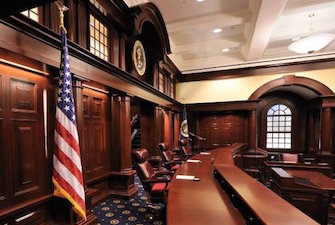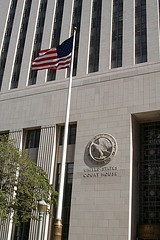Federal Circuit Affirms District Court on Infringement and Definiteness in Dow Chemical Case
 On January 29, 2016, the United States Court of Appeals issued a decision in AKZO Nobel Coatings, Inc. v. Dow Chemical Company, relating to an appeal from the United States District Court for the District of Delaware.
On January 29, 2016, the United States Court of Appeals issued a decision in AKZO Nobel Coatings, Inc. v. Dow Chemical Company, relating to an appeal from the United States District Court for the District of Delaware.
Akzo appealed from the district court’s granting of summary judgment that Dow did not infringe the claims of U.S. Patent 6,767,956, either literally or under the doctrine of equivalents. Dow cross-appealed from the court’s conclusion that the claims of the ’956 patent are not indefinite.
Claim 1 of the ‘956 patent was deemed representative and reads as follows:
1. A process for producing a dispersion of a polymer in an aqueous medium in which the polymer is dispersed in an aqueous medium in an extruder at a temperature above 100° C. in an extruder having an outlet
wherein the pressure in the extruder is maintained above atmospheric so that the aqueous medium does not boil characterized by maintaining the pressure above atmospheric for the extruder at the outlet with a pressurized collection vessel and
wherein aqueous dispersion from the extruder has at least 25% by weight of the aqueous medium where the aqueous medium has less than 40% by weight of organic solvent and
wherein the aqueous dispersion enters the outlet and pressurized collection vessel at a pressure above atmospheric so that the aqueous medium does not boil and is subjected to the action of a cooling zone to lower the temperature of the aqueous dispersion to below 100° C. to have an aqueous dispersion with a viscosity below 10 Pa.s.
Supreme Court Decides Commil USA v. Cisco Systems
On May 26, 2015, the United States Supreme Court decided Commil USA, LLC v. Cisco Systems, Inc., a case that dealt with inducement to infringe. More specifically, the issue considered by the Supreme Court was whether a good faith belief of patent invalidity is a defense to a claim of induced infringement. In a 6-2 decision written by Justice Kennedy, the Supreme Court ruled that belief of invalidity is not a defense to a claim of induced infringement.
Justice Kennedy started his substantive analysis with a discussion of direct infringement, which was joined by Justices Ginsburg, Alito, Sotomayor and Kagan. Justice Thomas, who joined in the majority with respect to Parts II-B and III, did not join the majority relative to the background discussion. Justice Thomas did not write a separate opinion so we can’t know for sure, but it seems that Thomas chose not to join parts of the decision that were historical in nature (Part I) and the part of the decision where the majority discussed substantive legal issues not specifically germane to the issue presented.
Moving beyond direct infringement being a strict liability offense, and inducement requiring direct infringement, Justice Kennedy ultimately reached the question presented, namely whether a good faith belief of patent invalidity is a defense to a claim of induced infringement. Kennedy explained: “[B]ecause infringement and validity are separate issues under the Act, belief regarding validity cannot negate the scienter required under §271(b).” Kennedy concluded: “Were this Court to interpret §271(b) as permitting a defense of belief in invalidity, it would conflate the issues of infringement and validity.”
Kennedy seemed sympathetic to those who argue that an invalid patent cannot be infringed, which seems to make common sense. But he went on to explain that logic and semantics sometimes must give way to interpretation of an otherwise clear statutory framework:
[T]he questions courts must address when interpreting and implementing the statutory framework require a determination of the procedures and sequences that the parties must follow to prove the act of wrongful inducement and any related issues of patent validity. “Validity and infringement are distinct issues, bearing different burdens, different presumptions, and different evidence.” 720 F. 3d, at 1374 (opinion of Newman, J.). To be sure, if at the end of the day, an act that would have been an infringement or an inducement to infringe pertains to a patent that is shown to be invalid, there is no patent to be infringed. But the allocation of the burden to persuade on these questions, and the timing for the presentations of the relevant arguments, are concerns of central relevance to the orderly administration of the patent system.
In addition to the statutory language that Kennedy found clearly on point, he explained that there were also several practical reasons why a good faith defense should not be allowed. For example, if someone believes that a patent is invalid, they should file a declaratory judgment action (assuming they have standing) or could file a petition for inter partes review with the Patent Trial and Appeal Board (PTAB).
Kennedy also specifically explained that the Court is mindful of abusive litigation tactics employed by so-called patent trolls. Raising the issue seemed wholly out of place and a bit odd given that Kennedy also quickly explained that in this case the parties raised no issue of frivolity. The issue of patent trolls must be weighing on the Court very heavily for it to be inserted by Kennedy in a decision where no one was alleged to have been a patent troll.
06.25.15 | Patent Issues, Patent Litigation, posts, Supreme Court Cases | Gene Quinn
Accused Infringer Uses Reexamination To Defeat Willfulness Allegation
Scott Daniels, partner at Westerman, Hattori, Daniels & Adrian LLP and Practice Center Contributor, sent along his analysis on the recent District Court decision, Plumley v. Mockett. In a decision that may surprise many, the District Court held that the accused infringer may use reexamination to obtain summary judgment of no willful infringement. According to Daniels, “the first goal of a third party requesting reexamination is to invalidate the patent claims. But even if the Patent Office confirms the validity of the claims, the reexamination may significantly benefit the requester on other issues, such as claim construction, infringement, and inequitable conduct.”
Below is Scott Daniels’ analysis…
A party accused of patent infringement requests reexamination at the PTO to attack the patent as being anticipated or obvious in view of a prior art patent or printed publication. An accused infringer, however, may also achieve other less obvious goals by seeking reexamination, such as creating an estoppel, creating a disclaimer limiting claim scope, or establishing the materiality of a prior art reference for an inequitable conduct defense. Or, as in Plumley v. Mockett, the accused infringer may use reexamination to obtain summary judgment of no willful infringement. 2010 U.S. Dist. LEXIS 57254 (C.D. Cal. May 26, 2010). (more…)
06.21.10 | District Court Cases, Patent Litigation, posts, Reexamination Requests | Stefanie Levine



No Comments
02.24.16 | Federal Circuit Cases, Patent Issues, Patent Litigation, posts | Gene Quinn